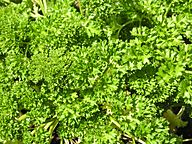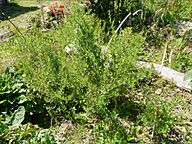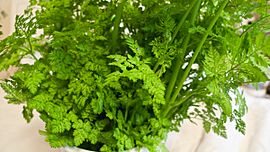Fines herbes facts for kids
Fines herbes (pronounced "feen-zerb") is a special mix of herbs used a lot in French cuisine. It's a key part of many classic French dishes. The most common fines herbes mix includes finely chopped parsley, chives, tarragon, and chervil.
Chefs use these herbs to add flavor to foods that cook quickly. This includes dishes like chicken, fish, and eggs. They are also great in light sauces, such as a beurre blanc sauce. Sometimes, fines herbes are even eaten raw in salads for a fresh taste.
Contents
What is the Classic Fines Herbes Mix?

For a long time, there has been a discussion about what exactly goes into fines herbes. In 1903, a famous chef named Auguste Escoffier noticed a problem. He saw that many dishes called "Omelette aux fines herbes" (omelet with fine herbs) only had parsley.
Escoffier believed this was wrong. He said that a true omelette aux fines herbes should always have parsley, chives, and a little bit of chervil and tarragon. Later, in 1938, a well-known cooking guide called Larousse Gastronomique agreed with Escoffier. They said that while many people only used parsley, the traditional way was to use a mix of these four fragrant herbs.
Famous cookbook author Julia Child also agreed with Escoffier. She said that fines herbes is a mix of fresh parsley, chives, tarragon, and chervil. Some food experts, like Harold McGee, even say that parsley isn't always needed. He suggests using tarragon, chervil, and chives. McGee also advises chopping the herbs with a sharp knife. This is better than using a food processor, which can change their flavor.
Can You Substitute Herbs?
Cooking traditions often change over time. Sometimes, chefs might use different herbs if they can't find the traditional ones. For example, the chef Pierre Franey once shared a story about making an omelet with fines herbes. He used chervil, parsley, tarragon, and chives.
However, in his recipe for people in the United States, Franey suggested using basil instead of chervil. This is because fresh chervil can be hard to find in some places. Dried chervil also doesn't taste as good. This shows that while there's a classic mix, cooks can adapt based on what's available.
Fines Herbes Versus Stronger Herbs
Fines herbes are known for their delicate flavors. They are often used in dishes that cook quickly. This is different from "robust herbs," which have stronger tastes. Robust herbs, like those in a bouquet garni (a bundle of herbs), release their flavor over a long cooking time. Examples of robust herbs include thyme, bay leaves, and sage.
So, fines herbes are for light, quick dishes. Stronger herbs are for stews and soups that simmer for hours.
See also
 In Spanish: Hierba aromática para niños
In Spanish: Hierba aromática para niños






